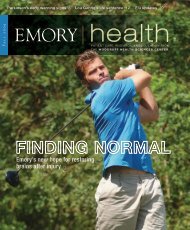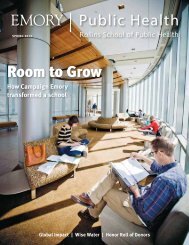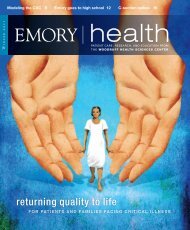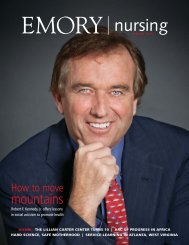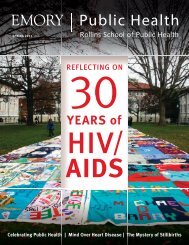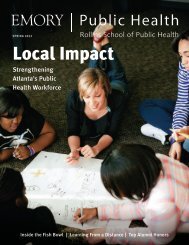Living - Woodruff Health Sciences Center - Emory University
Living - Woodruff Health Sciences Center - Emory University
Living - Woodruff Health Sciences Center - Emory University
You also want an ePaper? Increase the reach of your titles
YUMPU automatically turns print PDFs into web optimized ePapers that Google loves.
Telling our stories<br />
With a $1.6 billion<br />
campaign in full swing,<br />
<strong>Emory</strong> is speaking up<br />
about the good it can do<br />
for health and healing.<br />
OR tHE PASt 15 yEARS, <strong>Emory</strong> <strong>University</strong> has been quietly going<br />
about its business. Educating generations of health care providers.<br />
Recruiting scientists of international repute. Discovering life-saving<br />
drugs. Growing its outside research funding faster than all but one<br />
other school in the country. But despite <strong>Emory</strong>’s steady climb into the ranks<br />
of America’s best 20 universities, it sometimes has remained less visible than<br />
many of its peers.<br />
By Rhonda Mullen • Illustrations by Nate Williams<br />
<strong>Emory</strong> is now ready to make up for its lower profile. In<br />
September, the university launched its first campaign in 15 years. Its<br />
goal of $1.6 billion marks the biggest fund-raising effort in <strong>Emory</strong>’s<br />
history and the biggest ever in Georgia, and the university is already<br />
more than halfway to meeting that goal. Of the total amount, 2/3 of<br />
the money raised—some $1.07 billion—will go to health sciences.<br />
Fred Sanfilippo, <strong>Emory</strong>’s executive VP for health affairs and<br />
CEO of the <strong>Woodruff</strong> <strong>Health</strong> <strong>Sciences</strong> (WHSC), is no stranger to<br />
campaigns. During his tenures at Duke, Hopkins, and Ohio State,<br />
he says that “all those institutions were continuously in campaign<br />
mode.” By contrast, “folks here are not in the habit of spreading the<br />
message of what we’re doing and why it’s valuable. We don’t tell our<br />
stories well or often enough.”<br />
For that reason, Sanfilippo sees Campaign <strong>Emory</strong> as an important<br />
and welcome cultural shift for the campus. “the campaign is<br />
about more than dollars,” he says. “It’s about educating people about<br />
what we do and why it’s important and getting them engaged. It’s<br />
about raising our visibility and impact, which in turn raises support<br />
for what we do.”<br />
He learned the value of raising visibility by watching his wife,<br />
Janet, run the first campaign for the children’s hospital and center<br />
at Duke in the early 1980s. While Sanfilippo was impressed by the<br />
celebrities who participated (Perry Como, Frank Sinatra, Gerald<br />
Ford) and the engagement of thousands of people, he was surprised<br />
that the campaign didn’t generate much money. “I was naive back<br />
then,” he says. “I thought it was all about the money. But what happened<br />
was that raising the awareness for the Duke children’s center<br />
in that campaign allowed the center’s fund-raising to really take off<br />
within the next five years.”<br />
these many years and multiple campaigns later, Sanfilippo<br />
knows that what a successful campaign really does is “increase the<br />
awareness and level of engagement of those we serve—patients and<br />
families, students and parents, faculty and staff, corporate partners<br />
and foundation friends. It helps us do a better job of serving them<br />
downstream.<br />
“Service in the health sciences encompasses a broad range of<br />
support for people, places, and programs with the goal of transforming<br />
health and healing,” says Sanfilippo. “It involves development<br />
of a new model for health care, a switch from treating disease to<br />
creating health. It involves building new facilities that not only have<br />
state-of-the-art technology but also center on patients’ and families’<br />
needs. It means discovering the basic science behind today’s biggest<br />
killers and translating those findings into new treatments and cures.<br />
It means building an endowment for health care to make sure it is<br />
growing and vital for future generations.”<br />
these past 15 years, <strong>Emory</strong> has, in fact, been engaged on all<br />
these fronts. But now, to continue to grow, to go to the next level, it<br />
needs to raise both money and visibility. It’s time to speak up.<br />
Dining at the animal house<br />
the fall dinner party that Stuart Zola hosted wasn’t just any<br />
Friday night get-together. the event brought Zola together<br />
with 16 strangers, so to speak. the 16 were <strong>Emory</strong> students<br />
who had signed up to dine with the director of the yerkes<br />
national Primate Research <strong>Center</strong>. And helping Zola host were<br />
six yerkes employees, including a vet, researchers, and staff<br />
members, three of whom were <strong>Emory</strong> graduates themselves.<br />
the occasion gave Zola a<br />
chance to talk about a favorite<br />
topic—the critical role animals<br />
play in scientific progress and<br />
life-saving medical developments.<br />
At yerkes, one of only<br />
eight research centers designated<br />
by the nIH as a national<br />
primate research resource,<br />
animal research has led, for<br />
example, to a promising AIDS<br />
vaccine and discoveries about<br />
age-related neurodegenerative<br />
diseases such as Alzheimer’s.<br />
One of Zola’s priorities is<br />
to tell the stories of yerkes, and there are many. Scientists at<br />
yerkes are exploring new imaging technologies to tailor medications<br />
to treat cocaine addiction. they are examining the role<br />
of cells in controlling immune responses, with applications for<br />
preventing organ rejection after transplant. And researchers are<br />
working on treatments and a vaccine to treat Alzheimer’s.<br />
yerkes also shares its stories through a program that takes<br />
researchers into the community and brings students and others<br />
to the center for hands-on experiences. Last year, along with<br />
hosting these groups, yerkes opened its doors to nine <strong>Emory</strong><br />
freshmen mentoring groups, and during fall and spring finals<br />
weeks, sponsored study breaks, providing another opportunity<br />
for <strong>Emory</strong> students to interact with staff.<br />
Public education is a slow process, demanding patience,<br />
hard work, and a commitment to truth, but Zola believes it is<br />
vital that the community understand what yerkes is about and<br />
the good it is doing for health. “Researchers have a new part to<br />
their job description: to educate, explain, and counter the misinformation<br />
that can be damaging to our work,” he says.<br />
8 eMory heAlth<br />
Winter 2008-2009 9



